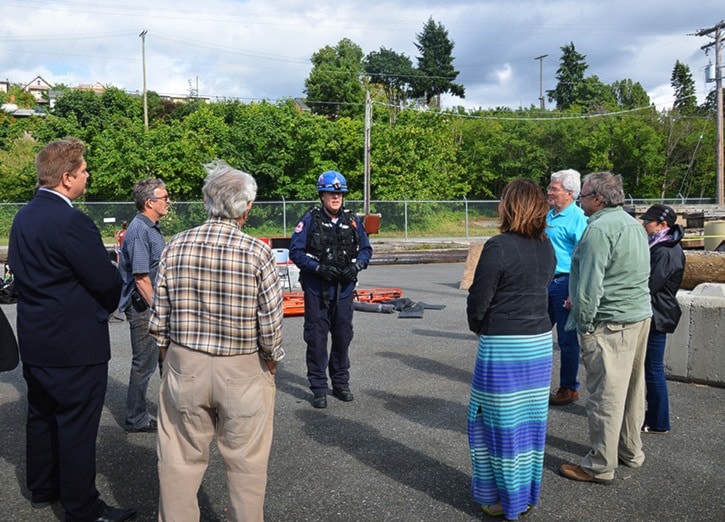Participating in Exercise Coastal Response has staff and elected officials alike feeling more prepared for a disaster.
“For us, it really worked well,” said Alberni-Clayoquot Regional District CAO Russell Dyson, referring to the emergency operations centre (EOC) set up by the regional district. Dyson served as director of the EOC.
Emergency Coastal Response was the province of B.C.’s first full-scale tsunami and earthquake preparedness event. It took place last week and cost the province $1.2 million to carry out.
“The real challenge was to bring in a lot of personnel over a very short term and what we were really impressed with was just how well everybody worked together,” said Dyson, adding that local staff were very much surprised on a daily basis by the mock events and scenarios.
“Before the event I kept myself from knowing what would happen. In the EOC, we were hearing from the controllers or from the field reports and it was all completely new to us.”
Locally, only fire Chief Tim Pley knew the entire exercise scenario—or as the province put it, “the fire chief is dead.”
Comparing the plan to the carried out exercise, Pley—who is also the acting CAO for the City of Port Alberni—said they mirrored each other well.
“I think it matched up about as well as it could. Exercises are hard because you’re role playing and pretending,” said Pley.
Regional district staff worked alongside City of Port Alberni staff, professional and volunteer firefighters, RCMP, emergency social services, search and rescue personnel, the Salvation Army, hundreds of volunteers and the Vancouver-based Task Force 1 heavy urban search and rescue team.
“They gelled and they really worked well together as a team,” Dyson said.
Communications were carried out by the Amateur Radio Club via satellite phone and ham radio both internally throughout the Alberni Valley and to the province.
“For the first couple of days of the exercise, there were no cells, computers or otherwise—it was ham radio and satellite communications,” said Dyson, adding that the Amateur Radio Clubs across the Island prepped for the exercise in advance.
“That exercise in itself identified the need for their antennas to be located at different locations—they couldn’t just set up at Echo, they had to be in a particular area so there wasn’t interference,” Dyson said. While other radio systems weren’t at play throughout Coastal Response, the city’s, the ministry of forests and local logging companies would all be called upon for their radios in a real emergency.
The overwhelming amount of paperwork was an area that could use improvement, Dyson said.
“There is a lot of paperwork that we have to do and it’s understanding how to change or modify that to make sure everyone knows what’s going on,” he said.
The EOC served a vital role during Coastal Response—it took in information from the field and provided them with resources, as well as receiving instructions from the province.
“You have four sections—you have operations, which are the first responders, emergency social services working together getting information from the field and seeing what the needs are; then you have planning and planning is looking forward to what are our needs going to be in a day or two or a week down the road; then you have logistics and they are the ones that if we need resources they go out and get it; and then there’s the financial sector and they look after the paperwork and insuring that there’s the money available,” Dyson explained.
The EOC was staffed by regional district and city staff, as well as first responders and volunteers.
Along with internal personnel, volunteers were sourced from places outside the Alberni Valley including Parksville, Ucluelet, Nanaimo and the Toquaht First Nation—something that Dyson said will provide a good outside perspective.
The EOC emphasized fulfilling logistical needs locally when possible throughout the exercise.
“There’s contractors we do business with on a day-to-day basis—do they have the resources that we need? Then we looked to our partners such as Island Timberlands, Western Forest Products, Catalyst... do they have it?”
It was only when resources (whether personnel or equipment) were unavailable locally that the EOC went to the province.
“We’d make a very specific request to the province, i.e. we need so much and so many of these for this purpose.
The province will then draw on resources provincially or move that request up to the federal level.”
Plans are underway for a detailed report on how the exercise went.
“Everybody that was in the EOC has been given a form to fill out to give us their personal feedback. That’s what I’m looking forward to the most—if an individual was working in this, what do they see as what we can do better?” Dyson said.
The regional district will sit down with the province and all of the agencies involved on June 23 to do a detailed analysis of how the exercise went.
“It will be very helpful to see how the province, who we’re making requests from or sharing information from, how they managed to get our information and where we can improve on that.”
Staff will prepare a report to the ACRD board in approximately two months.
reporter@albernivalleynews.com
facebook.com/albernivalleynews
